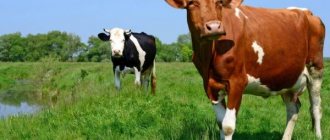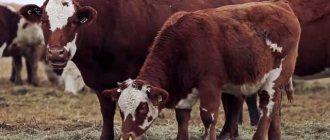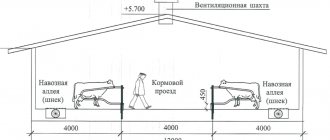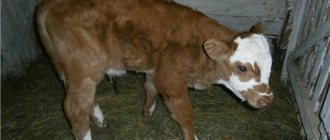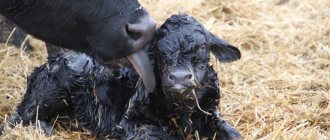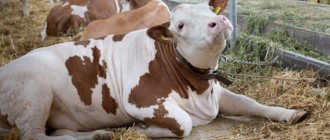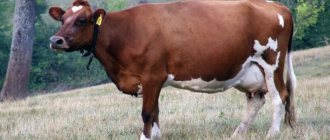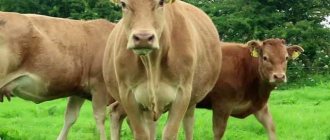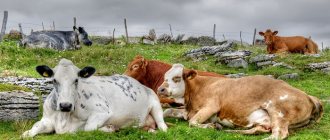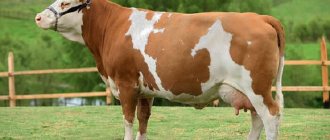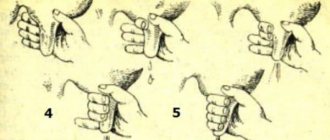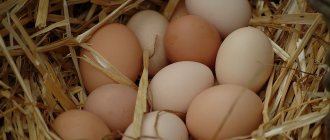How to fertilize?
Impregnating a cow on your own is not as difficult as it seems. We have already figured out that for individuals who have given birth, the manocervical method is best suited. For young heifers, use the other two methods to avoid damaging the vagina or cervix. Below is more detail about where to start the process and how exactly to carry it out.
Choice of animal
Finding a cow to breed with is quite easy. When stroking the back, the animal does not twitch, does not moo, and stands calmly. The labia may be swollen, enlarged, and first clear and then dark mucus may be released. It is recommended to impregnate the animal immediately after examining signs of heat. To consolidate the result, the seed is reintroduced after 10 hours. The duration of the hunt is about 20 hours. That is, if the moment is missed, the next procedure will be carried out only after 21-22 days.
Also, the readiness of the animal is determined vaginally and rectally, by feeling the vagina with the cervix and the follicles with the ovaries. In a “ready” cow, the ovaries and follicles are quite hard, and the cervix and vagina are swollen and mucous, which indicates imminent ovulation.
Preparing the room and animal
The stall area is washed and disinfected, and then the animal itself is cleaned. To clean the premises, use non-aggressive detergents and mild disinfectants. The first step after disinfecting the room is to wash your hands, put on gloves, and lubricate them with Vaseline. After this, the cow’s anus is manually cleaned of residual manure. Then they feel the cervix and the body of the uterus with its horns, and perform a massage.
After these manipulations, the cow’s labia, root of the tail and ischial tuberosities are washed with soap and then wiped dry. After which the labia and the root of the tail are washed with a solution of furatsilin - 1 tablet of furatsilin for 1 glass of warm water. Once these procedures have been completed, the insemination process itself can begin.
Fertilization process
It is important to find the cervix so as not to get into the urethra. Therefore, with any method of fertilization, preliminary palpation is carried out - the cervix is determined
Then they follow the standard scheme - they massage the cervix, wait for the uterus to tone (become hard), wait out vaginal spasms and insert a catheter. Quickly but gently squeeze the sperm out of the reservoir, and then hold the catheter inside for a while
Then they wait until a “suction” spasm occurs and very carefully, without sudden movements, remove the catheter
What to do after?
There are no special recommendations regarding the animal after fertilization. However, it is recommended that the expectant mother leave it for 20-30 minutes, without fussing or making noise. The fertilization procedure is quite responsible not only for the farmer, but also for the cow. If everything goes well, signs of heat will not appear for the next 10-12 hours, which will mean that your cow is pregnant.
Cattle fertilization techniques
Today the following methods of inseminating cows are used:
- Natural: free beam, hand mating.
- Artificial: manocervical, visorvical, rectocervical, transplantation.
The cow insemination table will help you figure out at what time it is better to use natural and at what time artificial methods. The initial phase of estrus lasts 8 hours: the natural method is inseminated 6 hours after the start, the artificial one will be useless. The active phase lasts 16 hours, ideal for artificial insemination; for natural insemination, the optimal time is the first 8 hours. Coming out of estrus lasts 8 hours - fertilization is not carried out.
Fertilization is carried out 2 times: at the beginning of the hunt and 12 hours before milking. Blood discharge is a natural process that indicates the animal has recently been in heat, but is not relevant to determining the success of conception.
The effectiveness of the techniques will be higher if the following insemination rules are applied:
- if the hunt starts in the morning, the procedure is carried out in the evening and in the morning of the next day;
- if the hunt starts in the evening, the procedure is carried out in the morning and evening of the next day;
- if the female is not out of heat after 2 procedures, insemination is carried out a third time.
There is a natural and artificial way to inseminate cows
Preparatory process
An important process is preparing females for conception. In the warm season, cows are free to range and are able to provide themselves with vitamins. After the last lactation, the cow needs rest. Until the moment of insemination, the animals are fattened and care is taken to ensure that they do not become fat. In winter, cattle are kept in dry, warm rooms, with adequate ventilation, and vitamin complexes are introduced into the diet.
After calving, cows are examined for postpartum injuries. Immediately before insemination, all premises are disinfected. Females and bulls are washed and their genitals are treated with a solution of manganese or furatsilin.
When implementing artificial methods, preparation follows a different pattern. After cleaning the room, the animal is restrained and gloves are put on. The anus is generously lubricated with Vaseline and the remaining feces are manually removed from the rectum. Then the cervix is determined by touch and massaged through the wall of the rectum. The tail, hind limbs, anus and vaginal lips are washed with warm water, then with furatsilin solution.
Free mating
The inseminating male is kept in a general herd of females, numbering 30-40 animals. More often, breeders try to keep 2-3 bulls in order to be able to change them every 2-3 days during insemination. If the male is alone, he is given rest once every 7 days. A bull is able to inseminate all females in the herd and in heat in one day.
The main disadvantage of the method is low efficiency. The bull only climbs on the cow once. If the male is not in the best physical shape, he may not have enough strength to fertilize several females. If the majority of free-roaming heifers remain unfertilized, this will significantly reduce the productivity of the herd.
During sexual contact, infections often occur. It is difficult to maintain the qualitative characteristics of breeding bulls with an intensive regime of fertilization of a large number of females. As a result, even in the best males, sperm activity decreases, which leads to low fertility, as well as the appearance of genetic pathologies.
Manual mating
This method involves keeping the bull separate from the females. A special machine is required on which the bull places its forelimbs. A cow is brought in when she starts bleeding from her labia.
Each male is assigned 35-40 females. Mating is carried out according to plan. With the same inseminator, the female is mated 2 times, observing a time period of 10-12 hours. Before starting the process, the animals are washed with their hind limbs and genitals.
The technique has a number of advantages compared to free mating. In a year, a bull is capable of covering 100-150 females. The farmer has the opportunity to provide the optimal number of sexual intercourses. Bulls' productivity increases if the following rules are followed:
- an adult male should make no more than 2-3 cages;
- at the age of 1.5 years, mating is carried out once a week, at 2.5 years - 2-3 times a week;
- the break for a male who has made 2-3 mountings is 24 hours;
- the mating room must be clean and dry;
- During sexual intercourse, the animals are alone in the room.
Artificial insemination methods
Methods for inseminating cows are varied. Each method involves inserting semen through the cervix.
Visocervical
Before the procedure, a specialist must evaluate sperm activity using a microscope.
To perform the manipulation, you will need the following tools:
- containers with tight stoppers, volume 100 ml, 4 pieces;
- containers with saline solution – 3 pcs.;
- container with alcohol – 1 pc.;
- alcohol-soaked wipes;
- sterile swabs;
- containers for used raw materials;
- stands for appropriate tools;
- expander;
- catheters;
- illuminated mirror.
Visocervical insemination method
Procedure:
- the anus and vagina are washed with a furatsilin solution;
- the mirror is disinfected, heated to a comfortable temperature, and inserted into the female’s genital tract;
- sperm is taken and injected into the cervix using a catheter;
- all instruments are removed from the genital passages of the individual.
In this case, tissue injury by the devices must not be allowed, otherwise the manipulation will not bring the desired result.
Rectocervical
This is the most popular method of fertilization. In this case, a playpen is not required, and insemination is performed directly in the stalls.
To perform insemination you will need:
- polystyrene pipette, volume 450 ml;
- gloves;
- syringe equipped with a coupling.
Algorithm for performing the manipulation:
- With the left hand, the animal’s intestines are rid of feces;
- the genitals are washed with a solution of furatsilin;
- the glove is treated with soapy water and the hand is inserted into the anus;
- perform palpation of the genital organs in order to possibly detect the corpus luteum;
- with the other hand they spread the female’s genital slit;
- drive the appropriate instrument;
- with the hand located in the anus, grab the cervix and find the end of the catheter with the little finger;
- the instrument is inserted into the cervix and advanced approximately 6-8 cm;
- sperm is injected;
- the instrument is removed from the female's body.
Rectocervical insemination method
Manocervical
To complete the procedure you will need:
- catheters;
- sterile ampoules;
- latex gloves.
Procedure:
- put on gloves and treat them with a low concentration saline solution;
- one hand is placed in the genital tract to understand how many centimeters the uterus has dilated;
- for 2 minutes the specialist massages the female’s vagina;
- a catheter with sperm is inserted into the cervix, immersing the instrument 7-8 cm;
- the contents of the catheter are completely poured into the cervix, it should be taken into account that sperm can be injected only at a time when the uterus is completely relaxed; if contractions begin, the massage is repeated.
Manocervical insemination method
The hand with the tools is carefully removed from the female so as not to accidentally injure the tissues and cause pain to the cow. If the animal feels severe discomfort, the sperm will flow out, which will negate the specialist’s efforts.
When the manipulation is completed, repeated massage is required so that the material is not expelled by the cow's body.
Massage through the rectum before insemination
This method has some disadvantages:
- cannot be used for young and small females with a narrow vaginal lumen;
- instruments must be processed with the utmost care;
- The procedure can only be performed by a professional with extensive experience.
Epicervical technique
A distinctive feature of this method is its similarity to real insemination. The sperm is not injected into the uterus, but into the vagina or cervix.
The algorithm will be like this:
- by hand, the animal’s intestines are rid of feces;
- the genitals are washed with a solution of furatsilin;
- massage the clitoris;
- the hand is inserted into the anus and the uterus is massaged;
- the catheter is placed into the vagina and the raw material is poured out;
- the tool is removed.
Machine with clamps for artificial insemination of cows
The procedure has the following indications:
- young individuals who do not have uterine distension during pregnancy;
- females of small breeds.
Common mistakes
The following mistakes should not be allowed when carrying out artificial insemination of cows and heifers:
- Unsanitary conditions. Staff may not adhere to the rules of personal hygiene, wear dirty clothes and shoes, and also neglect the rules of hygiene for the cow, ignoring washing and disinfecting its genitals.
- Lack of special premises. The procedure is sometimes carried out in barns in the presence of other individuals from the herd - in such conditions it is impossible to create sterile conditions and guarantee that infection will not enter the genital tract of the inseminated female.
- Use of non-sterile reusable instruments. This contributes to the spread of sexually transmitted infections from individual to individual.
- Lubricant on insemination instruments. When using glove lubricant, the operator may accidentally touch the catheter or syringe. This is dangerous because most lubricants are spermicidal, that is, they destroy the sperm cell.
- Improper storage of ejaculate. Sperm is stored only frozen in liquid nitrogen. Even short-term thawing and re-freezing are not allowed. Such errors negatively affect sperm viability.
- The tip of the catheter enters the urethra. This error occurs among inattentive beginners who do not direct the catheter at an upward angle of 30°.
- Insertion of the catheter tip into the uterine cavity is too deep. This is dangerous because the wall of the uterus can be accidentally pierced or an infection can be introduced inside.
- Injection of sperm into dead-end areas. Newbies encounter this error. There are dead-end zones in the vagina (for example, a round blind pocket that encircles the cervix and deepens up to 2.5 cm). It can be confused with the cervical canal. Also, sperm can spill out from the cervix into the vagina if the catheter is not removed into the uterus, but the seminal fluid is released in the cervical canal. It also has pockets and curves. To avoid such mistakes, you need to carefully monitor your actions and guide the catheter with your fingers, feeling the path of its advancement.
Important! The specialist performing insemination (inseminationist) requires experience in carrying out such procedures, as well as a thorough knowledge of the anatomy of the genital organs of cows. Inexperienced specialists often make mistakes during the procedure, after which conception either does not occur, or the health of the animal may be harmed.
The procedure for artificial insemination of cows and heifers is not very simple and cannot be used independently by an ordinary farmer without creating suitable sterile conditions. The probability of conception after such fertilization is very high and allows you to quickly inseminate a large number of cows with exactly the genetic material that you need. It is best to carry out these manipulations at special insemination points with the help of an insemination technician with appropriate zoological education and work experience.
Timing
Animals reach sexual maturity by 8-10 months. However, the cow inseminator chooses animals 1.5-2 years old. At this age, heifers reach 70% of the weight of an adult animal and are able to bear a healthy and strong calf. We should not forget that the puberty of a cow depends on the quality of nutrition, living conditions, climatic conditions, general health and many other factors.
Repeated artificial insemination can be carried out after childbirth only 30-40 days later. But this also depends on the physical condition of the cow, as well as its conditions on the farm and the time of year.
In order for the second calf to be born healthy and the cow to feel well, the inseminator carries out repeated fertilization 60-70 days after the first birth. To increase the likelihood of conception, the animal must be inseminated twice during sexual desire, the interval between procedures is 12 hours.
After insemination, approximately half of the cows bleed from the vagina. This is not an indicator of conception or its absence - it is simply a physiological feature that is not considered a problem.
Artificial insemination of heifers is carried out at a certain period when the animal’s body is ready to conceive.
How to identify a cow that is ready for insemination?
So we have figured out the main methods of artificial insemination. True, during all this time the question of how exactly to identify a cow that is ready for the insemination procedure was never raised...
In principle, this is quite simple to do. If you stroke such an animal in the area of the sacrum and pelvis, then it stands calmly, making no attempt to kick you. The outer labia become somewhat swollen, and a small amount of clear or slightly dark mucus may come out of them. Such a cow should be inseminated after waiting a couple of hours after the start of the hunt. After 10 hours, it is recommended to repeat the procedure. It should be remembered that the hunt lasts only about 20 hours, and therefore the next attempt will be available only after 20-21 days. The best time to inseminate cows is morning.
Experienced technicians can check a cow's readiness for insemination by finely palpating the ovaries during a rectal examination. In a “ripe” animal, we can clearly feel the ready-made follicle, which is about to burst, releasing the egg. Let us remind you once again that only a very experienced and careful specialist can do such a study, since a careless technician will almost certainly damage the follicle, making further insemination pointless.
Advantages of the method
Visocervical method of artificial insemination of cows
The use of artificial insemination has many benefits that livestock breeders and farmers should keep in mind. The advantages of the cow insemination method include:
- reduction of sexually transmitted diseases through direct contact between males and females;
- using high quality semen from the best breeding, titled males from all over the world;
- strict sanitary and veterinary control of the semen of breeding bulls;
- the ability to transport seed material without the need to transport the animal itself, long-term preservation;
- saving funds intended for the maintenance of a sire;
- the possibility of inseminating a large number of cows with the sperm of one bull;
Manocervical method
So, you already know what “cervix” is.
And “manus” is a hand. So the method is very similar to the previous one, with one exception - the vaginal speculum is not used with this method. As in the two previous cases, before starting work, it is necessary to thoroughly rinse the external genitalia with a solution of furatsilin or potassium permanganate, and then, taking a syringe with a dose of semen in your hand, insert it into the vagina. The operator finds the cervix, inserts a syringe there and squeezes its contents into the organ cavity. In principle, the technique of inseminating cows using this method is completely similar to the vizocervical method. But there is still a slight difference, which consists in a lower risk of infection, since no unnecessary tools are used.
Determination of pregnancy
Pregnancy in females begins from the moment of insemination and ends immediately after birth. The gestation period for a calf is 9 months.
Pregnancy is most often determined by two methods:
- rectally;
- vaginally.
Rectal examination of cows
However, a more accurate answer can only be obtained through a blood test. It is done 20-23 days after insemination. If the study shows an increased level of progesterone, then pregnancy has occurred.
In addition, livestock farms use a calving calendar for cows based on the date of insemination. This allows you to predict the growth of heads in the herd and prepare for fertilization.
If pregnancy does not occur after the manipulation, the cause is determined and, if necessary, the animal is treated.
Sexual heat in cows: signs and beginning of the rut
A cow in heat looks different than outside the rut. During this period, she may behave unusually. On small farms, observing cows is not difficult.
Females in heat are able to exhibit:
- anxiety, aggression, active movement around the pasture;
- poor appetite;
- increased respiratory rate and pulse, fever;
- reduction in milk yield;
- increased interest in males;
- showing interest in the genitals of other cows, etc.
On large farms, special techniques are used that give reason to plan insemination.
Unusual behavior of a cow during the rut
Cows are polycyclic animals. Alternating hormonal changes occur every 18-24 days. The usual length of the general cycle is 21 days. There are certain cyclic phases:
- excitation;
- braking;
- balancing.
At the first stage (excitement), eggs are actively maturing, estrogen levels in the blood increase, which is associated with the onset of estrus. The hunt itself can last only 10-20 hours. At this time, physiological changes become apparent: mucus discharge from the genital tract, swelling of the vulva.
Atypical behavior: cow imitates covering
During this period, the animal's genitals turn red. The uterine cervix relaxes and half opens. It's easy to place your finger in it. Mucous discharge is observed (at first - liquid and transparent, then - thick and viscous). Sometimes - with a slight admixture of blood.
A probe bull unmistakably identifies a female in the rut. To date, this natural method is the most effective. It operates in large herd environments. With its help, you can determine a cow ready for fertilization with a probability of 99%. For this purpose, sexually mature young animals are used, in which the testicular canals are surgically isolated. They may experience natural sexual desire, but are not capable of fertilization. For 1-2 hundred cows, one male is enough.
Using a sample bull in a herd environment
Often a bucket of paint is attached to the bull's neck to mark the cows he has had contact with. The livestock is checked twice a day. Those females that develop characteristic markings on their backs are removed from the herd and prepared for insemination.
On large farms, other methods for detecting heat in cows are also common:
- temperature measurements (rectal, vaginal, in milk);
- “fern leaf” (cervical mucus analysis);
- pedometric (analysis of the nature of movements, activity);
- measurements of vaginal electrical resistance (at the time of ovulation, resistance indicators sharply decrease due to increased moisture in the vulvar tissue).
Video - Cow in heat
All of the above methods and behavior are applicable and characteristic only of healthy individuals. There is a problem of false hunting in livestock farming. The causes of the phenomenon are different - from poor nutrition to neoplasms in the body (cysts). In the latter case, the female genitals become enlarged. The animals behave restlessly and are constantly interested in males. Treatment of the phenomenon is difficult due to the unknown etymology.
Preparing cows and heifers for insemination
The normal fertility of cows and heifers during artificial insemination largely depends on the condition and proper preparation of the animal.
Heat in cows and heifers is detected by milkmaids, cattlemen, foremen, farm managers with the participation of an artificial insemination technician at least 2 times a day (in the morning - during active walks or grazing, in the evening - during milking and caring for cows). Cows are inseminated only after restoration of the uterus and ovaries after calving, regardless of the timing of sexual heat.
Replacement heifers (aged 14-16 months) - when they reach body weight and height at the rump in accordance with the standard established for each breed (3/4 of the weight of an adult animal of a given breed).
When inseminating cows and heifers, they adhere to the “golden” rule “morning-evening”
, for the first time, when heat is detected in the morning, the animal is inseminated in the evening; when heat is detected in the evening, it is inseminated in the morning. In the evening, heifers and first-calf heifers are inseminated, since their heat is shortened compared to full-aged animals. Cows are inseminated again after 10-12 hours if they have not ovulated.
If the operator has sufficient knowledge and experience in rectal determination of follicle maturity seed, then a single insemination of cows at the end of the heat is allowed.
Attention!
The artificial insemination operator should only inseminate clinically healthy cows and heifers. Contraindications to insemination are:
- incomplete involution of the uterus;
- inflammatory processes in the genital tract, characterized by deviations in the consistency of mucus, the presence of flakes and streaks of pus;
- pain reaction of the animal to rectal examination.
Preparing instruments for artificial insemination
Preparation of instruments for insemination with sperm frozen in straws
To inseminate cows with sperm frozen in polypropylene straws, a universal syringe catheter or SHO-3 and sterile disposable plastic covers are used. One of the corners of the bag with sterile disposable covers is wiped with a swab moistened with 96° alcohol. Then cut off a corner with disinfected scissors and push the sterile cover out 1/3 through the incision. Sperm in straws is thawed in a water bath or defrost at 38-40°C for 10 s.
After thawing, wipe the straw dry with a gauze napkin and, holding it by the end, shake it so that the air bubble falls towards the cork.
Having pulled the piston of the syringe-catheter 90 mm, insert the straw all the way into the syringe-catheter so that the air bubble is located outside. Using disinfected, sharp scissors, cut off the end of the straw below the plug (leaving the tip of the straw protruding from the catheter by approximately 5 mm).
A sanitary cover is put on the syringe-catheter with a slight tension so that the protruding end of the straw fits tightly into the conical part of the cover, and the cover is securely fixed on the syringe-catheter with a spring clip or lock washer.
By lightly pressing on the piston, remove the remaining air bubble from the straw and, squeezing out a little sperm, check the tightness of the contact between the end of the straw and the sanitary cover (you must ensure that sperm does not get into the space between the straw and the sanitary cover). In this case, the main part of the syringe-catheter assembled with a sanitary cover is in the protective packaging of the sanitary cover.
The loaded instrument is transferred to the insemination site so as to prevent premature cooling of the sperm.
The sequence of work of the operator for artificial insemination
Preparation of instruments for insemination with sperm frozen in open granules
To inseminate cows with sperm frozen in open granules, use sterile disposable polystyrene pipettes connected by a polyethylene adapter or elastic tube 30-50 mm long with a 2-5 ml syringe.
One of the corners of the bag with polystyrene pipettes is wiped with a swab moistened with 96° alcohol, the corner is cut with disinfected scissors or broken through with the end of the pipette, and the pipette is pulled out through the hole by 1/3 of the length.
The pipette is connected through an adapter or elastic tube to the syringe, the syringe piston is moved back by 1/3, creating a supply of air in the syringe to completely remove sperm from the instrument during insemination. Open granules are thawed at a temperature of 38-40°C for 8-10 s.
Connecting a polystyrene pipette with a syringe
A polystyrene pipette connected to a syringe is removed from the bag, the free end of the pipette is lowered into a bottle with thawed sperm and, carefully pulling back the syringe piston, sperm is drawn into the cavity of the pipette. Holding the pipette vertically, with the syringe down, check the tightness of the instrument, observing the position of the sperm column in the pipette: it should not move down.
The pipette with sperm is placed in a sterile cover or disposable glove with the syringe facing out. The notched corner of the bag with the remaining sterile polystyrene pipettes is bent and secured with a paper clip or clip.
The remaining work is performed in the same way as when preparing an instrument with seeds frozen in straws.
Thawing of sperm in granules and its evaluation
To thaw sperm frozen in open pellets at artificial insemination points, you must have:
- sterile glass bottles with a volume of 10 ml;
- 2.9% solution of sodium citrate, packaged in ampoules of 1 ml;
- water bath or special defrosts;
- alcohol thermometer up to 50°C;
- sterile anatomical tweezers 25-30 cm long;
- sterile gauze wipes;
- towel;
- tampon holder with tampons soaked in 96° rectified alcohol;
- tripod;
- microscope with heating stage;
- clean slides and coverslips;
- protective glasses.
Before starting work, wet clean the desktop and disinfect its surface with alcohol swabs. The sterile instrument is laid out on the work table, a water bath or defroster and a microscope with a heating stage are turned on.
The required number of vials or ampoules with 1 cm3 of 2.9% sodium citrate solution are placed in a water bath or defrost, and clean slides and cover slips are placed on the heating stage of the microscope.
After the temperature of the water bath or defrost reaches the operating range (38-40°C), put on safety glasses, open the lid of the Dewar flask, cool the jaws of the tweezers by immersing them in liquid nitrogen, quickly pull the canister with sperm to the upper third of the neck of the vessel and remove one granule and quickly transfer to a bottle or ampoule with 1 cm3 of 2.9% sodium citrate solution.
The time from removing the granule from liquid nitrogen to transferring it to a water bath is no more than 5 s, and the time for thawing the granule in the defrost is 8-10 s.
During thawing, the bottle or ampoule is gently rocked, without removing it from the water bath, until a thin rod of ice appears in the granule. After thawing the sperm, the bottle or ampoule with sperm is immediately removed from the water bath or defrost, wiped dry and placed in a tripod. The temperature in the point's premises should not be lower than 18-20°C.
A drop of thawed sperm from a bottle or ampoule is applied to a glass slide lying on a microscope heating stage at a temperature of 38-40°C with a glass rod or pipette, covered with a cover glass and assessed. The quality of thawed sperm is determined under a microscope by sperm motility. If the assessment is positive, she is placed in the insemination instrument. Thawed sperm must be used within 10-15 minutes.
Strictly prohibited
Thaw pellets at room temperature or more than one pellet in one vial, and also leave thawed sperm in a water bath or defrost.
Uncoated granules of frozen sperm should be of a regular round shape with a volume of 0.2 cm3. Granules with a volume of less than 0.2 cm3 or having chips, as well as halves and fragments of granules must be rejected, about which a corresponding report is drawn up and a complaint is sent to the organization for artificial insemination.
Optimal timing of fertilization
Puberty in heifers occurs at 8–10 months, but conception should be allowed in a female who has reached 2/3 of the weight of an adult cow. If zoohygienic parameters are observed, this period occurs in 15–18 months. After calving, the cow can come into heat after 3 weeks. However, it passes slowly and is difficult to notice. This is not surprising; the uterus has not yet fully recovered after childbirth. The time between calving and the next conception is called the service period. The pursuit of excess production during insemination during the first estrus results in a risk to the health of the cow and its premature culling. Hormonal stimulation is also not advisable. The second or third post-calving heat, which occurs after 2.0–2.5 months, is considered optimal for insemination. In order for fertilization to occur with a high probability, insemination is carried out twice - immediately after detection of heat and after 12 hours. If the agitation does not stop, you need to inseminate the cow until she calms down.
When and how many times should artificial insemination be performed?
The average duration of the sexual cycle is 18-24 days, but there are individuals whose cycle is extended or shortened (respectively, more than 24 days and less than 18). In the first case, the cause may be missed heat, inflammatory processes in the uterus, death of the embryo, etc. In the second, the presence of neurohormonal disorders.
The optimal time for artificial insemination is based on the physiological characteristics of the cow after calving. The fact is that the functional abilities of the ovaries are restored quickly, but the uterus is not yet able to bear fruit again. As a result, conception does not occur, although the cow shows signs of rut. Therefore, it is necessary to inseminate animals no earlier than two to three months after the last calving.
Methods for determining heat in cows
Whether a female is in heat can be determined by her behavioral signs, however, this diagnostic method is not accurate, since most cattle have rather vague symptoms. The most common manifestations include:
- loss of appetite;
- anxiety, expressed in constant mooing;
- pink secretion of a pale hue and viscous consistency, released from the genitals.
There are other methods for identifying a female’s readiness for fertilization.
Body temperature measurement
The preovulation period is necessarily accompanied by a change in the female’s hormonal levels, which is manifested by a change in body temperature. In order to identify pathological abnormalities and the time of onset of heat, temperature measurements should be taken every day. Immediately before ovulation, the values will increase by an average of 0.3 degrees.
Probe Bulls
On farms, bulls with a keen sense of smell are necessarily bred. The process of estrus in cows is accompanied by the release of mucus, which has a specific odor. The so-called probe bulls catch it and begin to show interest in the female. If such a bull is accepted, the heifer is selected for insemination. The presented method is one of the most reliable for determining heat in cows.
Test bulls are animals that are sexually active but not capable of fertilizing.
Instrumental method
It involves taking a sample of mucus secreted from the female using a special instrument. When estrogen reaches its maximum levels, the mucous secretion acquires a special structure, which can be identified through microscopic examination. After the end of the hunt and the onset of ovulation, the mucus is transformed, characterized by crystalline disintegration.
Pedometry
As mentioned above, the period of heat in a cow is always accompanied by physical activity, which is what the pedometry method is based on. For diagnostic purposes, a special device is attached to the animal’s limb to record the level of activity. Monitoring is carried out daily, and the collected data accurately determines the highest peak of female activity, which always coincides with the beginning of heat.
Heat detector
It is a device capable of diagnosing the approach of estrus and the moment of ovulation. Externally it looks like a large thermometer, the tip of which is inserted into the internal organs of the cow and kept there for one minute. The disadvantage of this method is the high cost of the device.
Heat detector
Stimulation of reproduction of cows and heifers
Follimag
– contains gonadotropic hormone of blood serum of pregnant mares (GSZhK), purified from immunogenic proteins, has both follicle-stimulating and luteinizing activity in females, and in males it enhances the function of interstitial cells in the testes, testosterone synthesis, and, as a result, increased spermatogenesis and sexual intercourse activity. The drug is used to stimulate sexual estrus and treat ovarian hypofunction in cows.
Surfagon
– a hormonal drug (an analogue of gonadotropin-releasing hormone luliberin), stimulates the release of gonadotropic hormones of the pituitary gland luteinizing (LH) and follicle-stimulating (FSH) into the blood. Surfagon is used for early induction of the sexual cycle, treatment of hypofunction and follicular cysts of the ovaries, prevention of embryonic mortality, and increasing the fertility of females.
Oxytocin
– a synthetic polypeptide analogue of the hormone of the posterior lobe of the pituitary gland. It has a uterotonic, labor stimulating and lactotropic effect. Oxytocin stimulates milk secretion by increasing the production of prolactin from the anterior pituitary gland. Reduces myoepithelial cells around the alveoli of the mammary glands, stimulates milk flow. Used for weak labor, retained placenta, reflex agalactia, mastitis, uterine bleeding.
Endometromag - T, Endometromag - K, Endometromag - Bio
. These drugs are based on a patented antimicrobial complex, macrolide, aminoglycoside antibiotics, which have a bactericidal effect against gram-positive and gram-negative microorganisms, vibrios, leptospira, rickettsia, spirochetes, chlamydia and mycoplasmas and microscopic fungi, and also contain an agent that enhances myometrial contraction , activates the functional activity of the uterine glands and promotes endometrial regeneration. When using Endometromag-Bio during treatment, milk is used without restrictions.
Magestrophan
– active substance cloprostinol. The drug is synthetic, an analogue of prostaglandin F2ά, has a specific luteolytic effect and enhances the contractile function of the uterus. Its use in the luteal phase of the estrous cycle causes the resorption of the corpus luteum and thus creates the conditions for the onset of estrus and ovulation. It is used for luteal cysts, persistent corpora lutea, subinvolution of the uterus, endometritis, ovarian dysfunction (silent heat, anovulatory cycle), synchronization of the reproductive cycle, as well as for termination of pregnancy in case of fetal pathology.
Insemination after calving: timing and important nuances
Another important question that worries farmers is when to inseminate a cow after calving? Immediately after the birth of a calf, the new mother begins the lactation period. After a month, the peak of milk production occurs, which lasts about 4 months.
Immediately after insemination, the volume of daily milk production decreases markedly. Farmers strive to re-impregnate a cow as early as possible in order to again receive large volumes of milk and profit from it. The period from the moment of birth to re-insemination is called the service period. The owners themselves set the appropriate service period for each cow, based on its milk production. The following annual indicators are taken as a basis:
- Up to 4 tons of milk: fertilization occurs 28-30 days after calving during the 1st heat.
- 5 tons of milk: insemination will be most effective 50-53 days after calving (2-3 heat).
- More than 5 tons of milk: the service period extends to 70 days. If the birth took place without complications, the cow is provided with careful care and high-quality food, mating occurs after 3-4 heats.
The more productive the cow, the longer the service period lasts. On average, per 1 ton of milk there should be no more than 22 days of rest. But, as a rule, on large farms this rule is not given due attention: there insemination is carried out 58-60 days after the birth of calves. In private farmsteads, the cow is sent for mating 28-30 days after calving.
What are the dangers of early insemination after calving?
Some farmers do not think about when it is possible to inseminate a cow after calving without harm to her health. They want to send the animal to breeding as soon as possible so that they can start making a profit from selling milk. But this is not always correct. Thus, in cows with increased milk production after calving, sexual instincts decrease, and they do not come into heat for a long time. Insemination too early will not bring any results.
The situation is completely different with low-productive individuals. Cows, which produce about 4 tons of milk per lactation, are distinguished by well-developed sexual instincts. In them, early insemination will lead to more calves and increased lactation.
How to determine sexual heat
The most accurate sign by which you can determine the onset of sexual heat is estrus and arousal. At the moment, there are several ways to determine the readiness of the female’s body for mating. The first way is visual. The animals become restless, looking for a male, a white-transparent liquid oozes from the labia, which becomes thicker and whiter towards the end of the hunt. The disadvantage of the method is that the listed signs cannot be noted in animals with “quiet” hunting and in females with sore limbs.
The second method of determination is reflexological. For this method, they use a test bull, that is, they look at how the female will react to the presence of a male. The cow allows the bull to jump on top of her during the season. The method is quite inaccurate, since the probe is led to attached females, and often pregnant heifers accept the bull without complaint, while young heifers reject him even during the hunting period.
The third method is vaginal. Examination of the vagina with a speculum. During the hunting season, the mucous membrane will be swollen and red, and the fallopian tube will be slightly open. Clear mucus oozes from the fallopian tube, which accumulates at the bottom of the vagina in large quantities, then pours out through the external reproductive organs. The disadvantage of the method is the need to tie the animal; often in young females the dilation of the uterine cervix is rather weakly expressed.
The rectal method involves examining the ovaries through the rectum. At the beginning of the hunt, the mature follicle can be easily felt, and when pressed, the movement of fluid is felt. An immature follicle will be a hard tubercle, slightly protruding above the ovary. Among the disadvantages of the method, the need for frequent examinations is noted, which can lead to damage to the follicle and the release of the egg from it. The hormonal method involves determining the amount of progesterone in plasma, milk or urine. Ultrasound is the most accurate method. The disadvantage is expensive equipment.
Cow insemination
If possible, preference should be given to artificial insemination. In this case, the calf will be obtained from the sperm of more productive sires. In addition, artificial insemination eliminates the risk of contracting cattle diseases. The type of fertilization suitable for each individual individual is determined by the veterinarian.
Veterinarians advise carrying out this procedure not in the first, but in the second or even third heat, since in this case the possibility of successful fertilization significantly increases and the duration of lactation increases. In addition, to obtain a more reliable result, it is recommended to repeat the procedure after 12 hours.
General information about artificial insemination is given in the video.
Breeding and Calving Chart
The duration of the sexual cycle in cattle is three weeks. This period includes estrus, heat and ovulation. If insemination is carried out during the period of ovulation, the female becomes pregnant. On average, pregnancy lasts 285 days, but this period can range from 270-300 days depending on the age of the animal, the weight of the calf and the breed.
Figure 1. Table of breeding and calving dates for cattle
After determining pregnancy, the approximate launch date is calculated. As a rule, this period begins 7.5 months after mating. Below is a table that allows you to determine the calving date based on the week of semen injection (Figure 1).
Artificial insemination
Artificial insemination is a procedure during which sperm from a specific bull is injected into the uterus of an animal. It allows you to accurately determine the onset of pregnancy and monitor pregnancy. Using biological material from a bull, it is possible not only to maintain the purity of the breed, but also to fertilize several dozen females at the same time.
There are several methods of artificial insemination (Figure 2):
- Rectocervical - seminal fluid is injected with a special instrument directly into the cervix. The device is fixed through the anus, and the seminal fluid is diluted with saline to save biomaterial and preserve sperm motility.
- Visocervical: in this case, a speculum is first inserted into the vagina, which illuminates the cervix. After this, a dose of seminal fluid is administered with a special syringe.
- Manocervical - a polyethylene reservoir and a flexible catheter are used for the procedure. Inside the reservoir is sperm, which enters the vagina through a catheter. This method is considered one of the simplest, therefore it is used more often than others in household plots.
Figure 2. Types of artificial insemination in cattle
After all the manipulations have been carried out, the female must be observed, and if signs of heat do not appear after two weeks, fertilization has been successful.
Insemination using the rectocervical method
The rectocervical method is considered one of the best, since the seminal fluid enters directly into the cervical canal, and the chances of successful fertilization are significantly increased.
Figure 3. Technique and tools for performing rectocervical insemination
When carrying out this method of insemination, instruments are fixed into the vagina through the anus, and the veterinarian simultaneously massages the cervix to speed up the movement of sperm into the uterus. The procedure for carrying out this procedure is shown in Figure 3.
With rectocervical fertilization, the highest pregnancy rate is observed (up to 75%). In addition, this method is considered the fastest, and the possibility of infecting an individual with infections is minimized, since only sterile instruments are used for the procedure.
What are the different methods?
There are three ways in which artificial insemination of a cow can be carried out:
- rectocervical;
- visocervical;
- manocervical.
Rectocervical
With this method of fertilization, the prepared seminal fluid is injected into the cows directly into the cervix. For these purposes, sterile equipment is used, which is fixed through the rectal area. The animal is first prepared with a massage to remove possible instinctive spasms - a reaction to the introduction of a foreign object.
The apparatus for rectocervical insemination consists of a metal reservoir with a tube and a protective cover. The tube connects to the reservoir at one end, and is well secured with fingers at the other. A plastic bag with sperm is attached to the tube, a special piston is used to direct the liquid to the middle of the tube, and then the end of the tube is placed into the vagina.
Then squeeze out the contents to the end. The dosage of semen solution is 100 ml per adult cow. The liquid is supplied diluted with saline solution, this way the mobility of the sperm is preserved and the main raw materials are saved.
Visocervical
This method is considered by some to be more difficult. It consists in the fact that the inseminating operator first inserts a special viewing mirror with a light (previously disinfected and heated) into the animal’s vagina. After which the mirror is opened, the illuminator is directed to the cervix, and then a dose of sperm is delivered into the uterus using a catheter syringe. All instruments are sterilized and heated, sperm dissolved in saline solution is also heated to a temperature of at least 38°C.
Manocervical
It is carried out using a polyethylene reservoir with sperm solution and a flexible catheter made of the same material. This is the most common method used at home as the catheter is inserted manually deep into the cow's vagina. For hand protection and sanitary safety, the operator must use long protective gloves (up to the shoulder joint)
Important! This method is not recommended for nulliparous heifers.
Instrumentation for manocervical insemination includes a soft ampoule with sperm, a polyethylene catheter 7.5 cm long and 4.8 mm in diameter. A plastic container with sperm (or a previously prepared soft ampoule) is connected to a catheter, after which the contents are injected into the cow by the operator. The introduction is also made into the cervix, while the depth of penetration of the catheter (6-7 cm) is controlled manually.
Advantages of artificial insemination
The first experiments in fertilizing female animals without the direct participation of males were carried out in ancient times, but the technique received its main development in the 20th century, when its feasibility was proven.
The first and undeniable advantage is the mass nature of the procedure. Artificial insemination of cattle allows you to fertilize many females with one dose of sperm. If previously large dairy complexes had to keep several bulls, now their work can easily be done by one technician.
Artificial insemination of cows helps to avoid outbreaks of brucellosis, trichomoniasis and other diseases.
Prevention of epizootics. There are many diseases transmitted by contact in livestock farming. Infection of a bull contributes to the spread of pathology throughout the herd, and the artificial procedure involves the use of disposable instruments, sperm control and sterilization.
Obtaining the required offspring. Sperm processing techniques (centrifugation) make it possible to separate it by gender. This makes it possible to increase the number of bulls in beef cattle breeding, and heifers in dairy cattle breeding.
Choosing an insemination method
Insemination can be carried out naturally or artificially. In the second case, the manipulation must be carried out by a livestock specialist with the appropriate skills.
The methods for performing the procedure vary. These include the following methods:
- visocervical;
- rectocervical;
- manocervical;
- epicervical technique.
Hunting near cows
The most effective artificial or natural insemination is carried out during the hunting period. But since it is quite difficult to determine the duration of estrus in advance, mating is carried out in the first 10-12 hours after the first signs are detected.
How to spot heat
The onset of hunting can be determined by certain signs (Figure 4):
- The female becomes restless and constantly moos;
- The animal often runs away from the pasture or herd;
- Begins to arch the back and raise the root of the tail;
- Appetite decreases, the animal is constantly thirsty;
- Milk yield decreases sharply;
- Other females begin to jump on the individual, but she stands calmly. It is also possible that the cow herself begins to jump on others in the herd;
- The vagina becomes red on the outside, and clear (at the beginning) and then cloudy (at the end of estrus) mucus begins to secrete from it.
Figure 4. Signs of hunting
After detecting these signs, it is necessary to call a specialist who carries out artificial mating, or take the animal to a specialized point. When carrying out natural mating, the female is taken to the breeding station with the bull. You will find more useful information about hunting with cattle in the video.
https://youtube.com/watch?v=bP1meeEJJpM
Hunt synchronization circuits
If the farm contains a large number of livestock, hunting synchronization is used. This is a method by which the hormonal balance of heifers is altered so that they go into heat at the same time.
Figure 5. Hunting synchronization scheme
There are different synchronization schemes. As a rule, hormonal drugs are used for these purposes, which are administered at regular intervals (Figure 5). On the first day, drugs are administered that provoke premature ripening of the follicle and the onset of estrus. On the eighth day, the animal is given drugs aimed at regression of the corpus luteum and reducing the formation of new follicles. After another two days, drugs that induce ovulation are used, and the next day artificial insemination is carried out.
Heat detection methods
When the hunt begins, the female experiences excitement. This phase is divided into the following stages:
- estrus;
- hunting;
- ovulation.
Estrus
During this period, follicles mature and the level of estrogen in the blood increases. The genitals begin to secrete secretions, and the cervix opens. Mucus synthesized by the uterus begins to ooze through the passage. The vagina swells. In addition, the animal becomes restless, overly active, and mobile. The cow eats little or refuses to eat.
The duration of estrus is from 25 to 145 hours. There comes a time when artificial insemination of cows can be performed.
Hunting
A day after the onset of estrus, the hunt begins. It is during this period that experts recommend insemination. The procedure can be completed within 30 hours. The main sign that an animal is ready to conceive is complete immobility. If there is no male nearby, other females jump on the cow and pretend to copulate.
A cow jumps on another female and pretends to copulate
Ovulation
This stage occurs in the middle or end of the hunt. If there is sperm in the animal's uterus at the time of ovulation, conception occurs. Then the amount of estrogen in the blood normalizes. The cow becomes apathetic and loses interest in the bull. The animal begins to eat normally.
Ovulation ends either with pregnancy or with the beginning of the period of sexual rest.
Post-procedure care
For insemination to be successful, it is necessary to adhere to the rules for performing insemination and observe the frequency of the procedure. The favorable period is the physiological period for contact of germ cells.
In this case, it is recommended to consider the following points:
- The susceptibility of the egg to fertilization. This condition is observed for 10 hours. Next, the egg ages and its ability to fuse deteriorates. If insemination is performed at this time, the fetus may develop numerous pathologies. To avoid this situation, sperm must be in the genital tract until ovulation occurs.
- A set of physiological changes when sperm acquire the ability to penetrate an egg. Those cells that have already been placed in the female’s reproductive tract must prepare for the process.
- Sperm viability level. Natural fertilization allows the seed to remain active for 48 hours. For artificial raw materials this period is shorter and is only 12 hours. For this reason, preparations for insemination should be carried out 12 hours before the onset of ovulation.
Storing sperm frozen
Sperm must be introduced 2 hours before or 2 hours after the start of milking. The fact is that at this moment a dominant appears in the female’s brain. The main task is milk delivery. As a result, the absorption of sperm by the uterus is blocked. For this reason, insemination during milking will not bring the desired effect.
We suggest you read What to do if your cat doesn’t eat or drink, just sleeps
In the matter of artificial insemination, multiplicity is not the least important. The cow is injected with sperm twice:
- the first manipulation is performed as soon as the rut is detected;
- The procedure is repeated after 10 hours.
If the hunt does not stop, sperm is injected every 12 hours. Manipulations are stopped only when the characteristic symptoms disappear.
Usually mistakes are made by young specialists who have not had time to gain sufficient experience in performing the manipulation. The most common oversight is neglect of hygiene and safety rules. In addition, during artificial insemination the following mistakes can be made:
- Lack of a full examination of the uterus. This procedure is needed to determine the animal’s health status and the body’s readiness to conceive.
- Improper storage of sperm. Usually, a novice livestock specialist does not observe the temperature regime.
- Oblique cutting of ampoules. Such an error leads to the raw material getting into the syringe rather than to its destination. The quantity of semen is not enough and the procedure does not give results.
- Mishandling of a cow. This leads to injury to the animal and severe stress. As a result, the process fails, and the sperm loses its properties, which leads to losses for the herd owner.
If the rules were violated during the procedure, this can also lead to the fact that the manipulation ends in conception, but the cow cannot bear the fetus. In addition, the female’s body can become infected, which leads to illness and even death of the animal.
In order for artificial insemination of cattle to give a positive result and the cow to be able to carry a calf normally, the female should be provided with complete rest immediately after the procedure. The animal should be placed in a separate stall and the amount of food increased. The female is closely monitored for 2 weeks. After this, if the animal is in normal health, the cow is transferred to the herd. In this case, surveillance is not removed.
Pregnancy of a female can be determined by its characteristic features:
- 1.5 weeks after conception, a pregnant cow does not allow the bull to approach her;
- absence of a new heat.
Pregnancy or its absence can be determined by indirect signs only a month after insemination. If pregnancy has not occurred, the hunting period will begin. In this case, the procedure is repeated. If none of the 4 attempts brings results, functional disorders of the reproductive system are diagnosed.
Pregnancy can be determined by indirect signs only a month after insemination
Features of keeping cows after insemination
Immediately after artificial insemination, the animal should rest fully. To do this, separation from the herd is carried out - the cow is transferred to a separate room, where it is dry and warm. There are special conditions of detention that must be strictly adhered to:
- The cow's genitals are washed with soap and water.
- The vagina is disinfected using Furacilin solution.
- The animal is examined daily, especially the genitals, which may have been injured during insemination.
- The individual is kept in a separate room for up to 2 weeks.
- The amount of feed must be increased.
- Stressful situations are excluded.
Types and methods of artificial insemination of cows
Before insemination, the cow should be secured in special pens. The procedure must be carried out by trained personnel with the necessary education and experience.
According to the instructions, insemination of cows is carried out inside the cervix, this gives the best results. Currently, 3 methods are used for the procedure: manocervical, visocervical, rectocervical.
Manocervical method
Necessary equipment: disposable rubber gloves, 80 cm long, sterile ampoules and catheters for sperm.
Sterilization is carried out either by high temperature or UV radiation. The ampoule is filled with sperm and connected to a catheter.
Sequence of manipulations:
- The genital organs of the animal that will undergo the procedure are treated with disinfectant solutions;
- Using a gloved hand, previously soaked in a salt solution, determine the degree of dilatation of the cervix;
- If the results of the examination of the cervix are satisfactory, a vaginal massage is performed;
- A catheter with an ampoule is taken in the second hand, the catheter is inserted into the cervical canal, and then the ampoule is advanced deep into the uterus by 6-8 cm;
- The contents of the ampoule are squeezed into the uterus;
- The catheter and ampoule are removed into the vagina, then the cervix is massaged again, and then the instruments are completely removed.
This method of artificial insemination is not suitable for all animals in the herd without exception. A wide vagina is required for this.
For successful manipulation, asepsis requirements must be observed.
Visocervical method
Necessary equipment: gynecological speculum, syringes, catheters, lighting devices.
Syringes and mirrors must undergo the necessary sterilization treatment.
Procedure:
- Draw sperm into a syringe, releasing all the air;
- After restraining the cow, the external genitalia are treated with disinfectant solutions;
- A sterile speculum is inserted into the cow's vagina as far as it will go;
- The mirror is turned and opened to allow examination of the cervix;
- Then the speculum is covered, a catheter is inserted into the cervical canal at a distance of 4-6 cm, and the sperm is pushed out;
- All instruments are removed.
The procedure should only be carried out by an experienced and qualified specialist, since during this method of artificial insemination there is a high probability of damage to the mucous membrane of the animal’s genital tract.
Tools and equipment
To carry out artificial insemination of cattle (regardless of the specific method in which the manipulation will be carried out), the insemination point or room must be equipped with tools and materials. You will need:
- cotton swabs;
- sterile wipes;
- scissors;
- syringe;
- thermos with warm water;
- Dewar flask with frozen sperm;
- 70% alcohol solution;
- furatsilin solution;
- several containers for solutions;
- pan for used tools and materials;
- long sterile disposable gloves;
- laundry soap or antibacterial soap;
- clean towels;
- gauze.
Clothing of staff and inseminator operator includes:
- rubber boots or slippers;
- a cap or scarf for hair;
- protective apron;
- medical gown;
- medical face mask;
- clear safety glasses.
All staff clothing must be clean, ironed and close to sterile.
Shoes must be replaceable and clean, and not worn on the street. In addition to this instrumentation, which is common to artificial insemination, various instruments are used in each fertilization method, depending on its specifics. Important! Artificial insemination of cows cannot be put on a conveyor belt when several cows are inseminated with the same instruments. All materials must be either disposable (or they must be sterilized before fertilizing each subsequent female).
For rectocervical insemination, the following additional equipment is used:
- polystyrene catheter (length - 35-42 cm);
- disposable syringes with a coupling (2 ml) or polyethylene ampoules (48 mm);
- long sterile gloves (length - 80-90 cm).
For vizocervical use:
- syringes-catheters;
- vaginal speculum;
- illuminator;
- gynecological gloves;
- sterile swabs soaked in 96% alcohol;
- sodium citrate solution 2.9%;
- sodium chloride solution 1%;
- alcohol solution 70%;
- Furacilin solution 1:1.
To perform manocervical insemination you will need:
- sterile catheters 75 mm x 4.8 mm;
- ampoules with sperm;
- long gloves 80-90 cm;
- water;
- furatsilin solution;
- table salt solution 0.9%.
For epicervical fertilization the following is used:
- ampoule with ejaculate;
- polyethylene catheter (length - 40 cm);
- long sterile gloves up to 90 cm.
